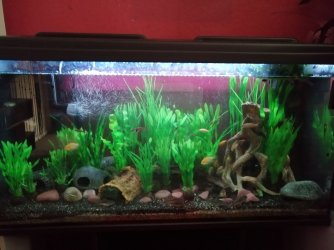OP
OP
Deleted member 149562
Guest
@GaryE
Aquarium & food.....nothing remotely special, different food mix each day.


The UV is something I have always used. Currently a 24w GKM. The aquarium is a 200 litre/53 US gallon with air curtain at the rear, RGB MCR lighting and a basic Aquael double canned Turbo 2000 internal filter.
Nothing special at all...and fake plants, mangrove root and rock hides too.
Aquarium & food.....nothing remotely special, different food mix each day.


The UV is something I have always used. Currently a 24w GKM. The aquarium is a 200 litre/53 US gallon with air curtain at the rear, RGB MCR lighting and a basic Aquael double canned Turbo 2000 internal filter.
Nothing special at all...and fake plants, mangrove root and rock hides too.

